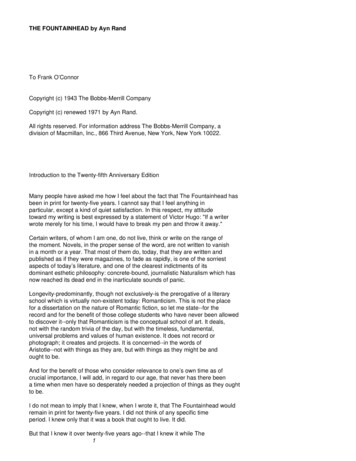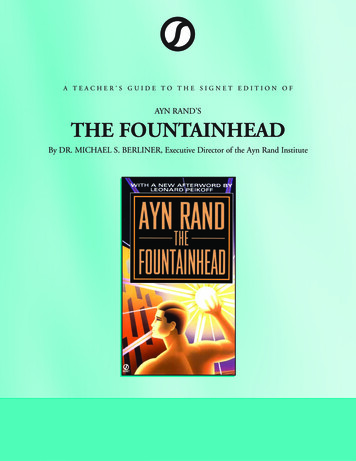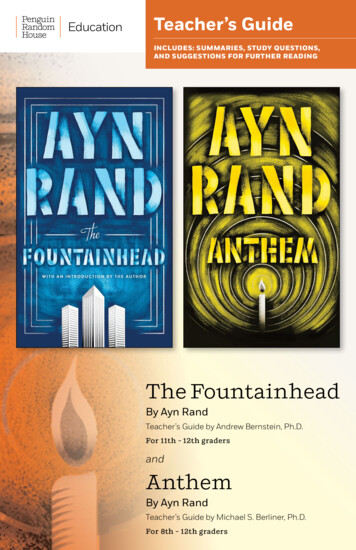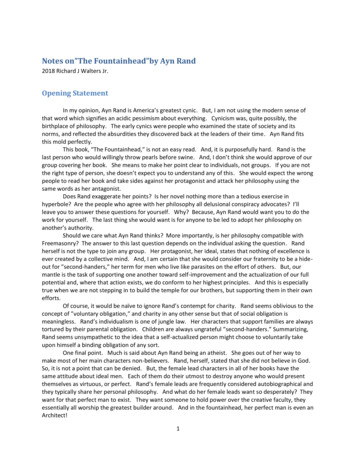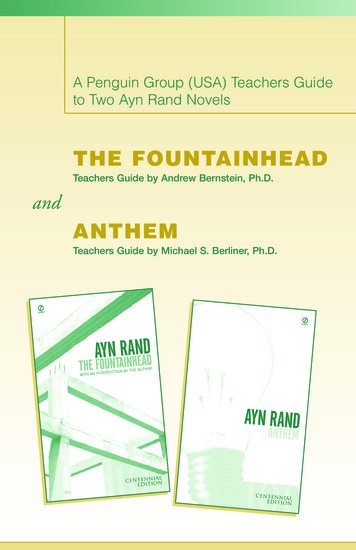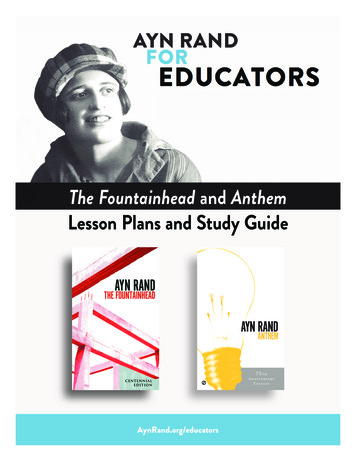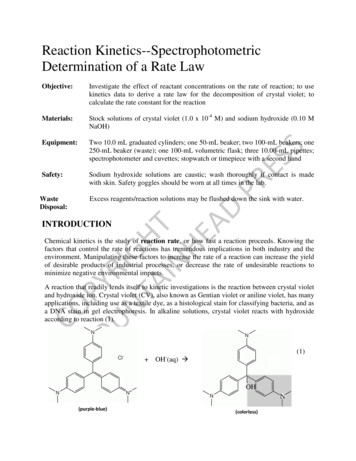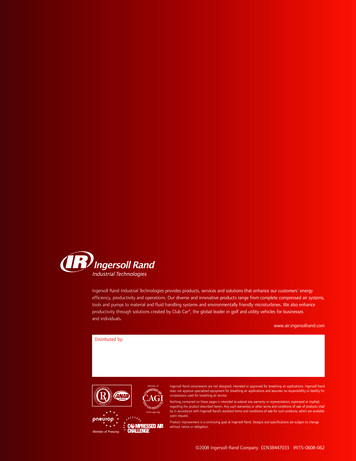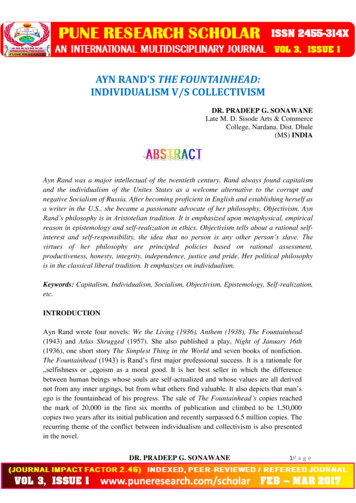
Transcription
AYN RAND’S THE FOUNTAINHEAD:INDIVIDUALISM V/S COLLECTIVISMDR. PRADEEP G. SONAWANELate M. D. Sisode Arts & CommerceCollege, Nardana. Dist. Dhule(MS) INDIAAyn Rand was a major intellectual of the twentieth century. Rand always found capitalismand the individualism of the Unites States as a welcome alternative to the corrupt andnegative Socialism of Russia. After becoming proficient in English and establishing herself asa writer in the U.S., she became a passionate advocate of her philosophy, Objectivism. AynRand’s philosophy is in Aristotelian tradition. It is emphasized upon metaphysical, empiricalreason in epistemology and self-realization in ethics. Objectivism tells about a rational selfinterest and self-responsibility, the idea that no person is any other person’s slave. Thevirtues of her philosophy are principled policies based on rational assessment,productiveness, honesty, integrity, independence, justice and pride. Her political philosophyis in the classical liberal tradition. It emphasizes on individualism.Keywords: Capitalism, Individualism, Socialism, Objectivism, Epistemology, Self-realization,etc.INTRODUCTIONAyn Rand wrote four novels: We the Living (1936), Anthem (1938), The Fountainhead(1943) and Atlas Shrugged (1957). She also published a play, Night of January 16th(1936), one short story The Simplest Thing in the World and seven books of nonfiction.The Fountainhead (1943) is Rand‟s first major professional success. It is a rationale for„selfishness or „egoism as a moral good. It is her best seller in which the differencebetween human beings whose souls are self-actualized and whose values are all derivednot from any inner urgings, but from what others find valuable. It also depicts that man‟sego is the fountainhead of his progress. The sale of The Fountainhead’s copies reachedthe mark of 20,000 in the first six months of publication and climbed to be 1,50,000copies two years after its initial publication and recently surpassed 6.5 million copies. Therecurring theme of the conflict between individualism and collectivism is also presentedin the novel.DR. PRADEEP G. SONAWANE1P a g e
The conflict is dramatized in the story of Howard Roark, an architect whose independentvision and unbreakable artistic integrity pits him against the mediocrity and conformismprevalent in his own profession and in the society first time. The Fountainhead is aHollywood film released in 1949 by Warner Brothers. Ayn Rand initially insisted thatFrank Lloyd Wright designed the architectural models used in the film. The severalrevised scripts were presented before filming started in 1948 under the direction of KingVidor. The Fountainhead is a representative illustration of Ayn Rand‟s writing. It detailsthe struggle of Howard Roark, a brilliantly creative architect who rejects conventionalstyles in a display of his own individuality. As a controversial novel, it is the story of anintransigent young architect, his violent battle against conventional standards and hisexplosive love affair with a beautiful woman who struggles to defeat him.James P. Draper is right in his observation: “The Fountainhead, chiefly through itscharacter, points up a number of paradoxes in our time and culture” (James, 364). Thefirst paradox is the drive for competition and success on the one hand versus the constantdemand for brotherly love and humility on the other. On one side, the individual isspurred on to greater and greater heights of success. It means that he must be assertiveand aggressive, while on the other he is deeply imbued by the principle and ideal ofunselfishness. A second paradox is that ones desires and needs are constantly keptstimulated, while the possibilities of fulfillment are slim or impossible. The third paradoxis that a gap exists between the alleged freedom of the individual and his actuallimitations. If all society is faced with these paradoxes, and all the conflicts implied inthem are essentially impossible to solve, then Howard Roark, the really well balanced andsecure individual will be the one considered neurotic by the society around him.The Fountainhead is a story of Howard Roark‟s triumph. It points out what the man is,what he wants and how he gets it. It has to be a triumphant epic of man‟s „I‟. It has toshow every conceivable hardship and obstacle on his way and how he triumphs overthem, why he has to triumph. Roark is Rand‟s vision of the ideal man. Although Roark‟scharacter may have faults, but as the protagonist of this novel, is eminently consistentwith Rand‟s belief about the heroic in man.The novel begins on a day when Roark is dismissed from the Architectural School atStanton. His striking originality does not fit in the accepted norms and the structure ofsociety. The Dean asks for conciliation in his architectural designs. Ayn Randpropounds,The Dean sat watching him curiously. Something puzzled him, not inthe words, but in Roark’s manner of saying them. “Rules?” said Roark.“Here are my rules: what can be done with one substance must neverbe done with another. No two materials are alike. No two sites on earthDR. PRADEEP G. SONAWANE2P a g e
are alike. No two buildings have the same purpose. The purpose, thesite, the material determine the shape. Nothing can be reasonable orbeautiful unless it’s made by one central idea, and the idea sets everydetail. A building is alive, like a man. Its integrity is to follow its owntruth, its own single theme and to serve its own single purpose. A mandoesn’t borrow pieces of his body. A building doesn’t borrow hunks ofits soul. Its maker gives it the soul and every wall, window andstairway to express it (Rand, FH, 24).The Dean says that Roark is expelled for turning in overly modern designs. The Deansuggests that he may be able to return to the school once he has matured. Roarkrefuses the offer. The Dean is offended and informs him that he will never become areal architect. Roark leaves the Dean‟s office and thinks about how he does notunderstand men like the Dean. Roark defends his decision to design things in his ownway. He tells the Dean that he has nothing more to learn from the school, so he has nointention of returning.Roark explains his architectural philosophy: “the purpose, the site, the materialdetermine the shape” of a building. He states simply that the days of classical designare over. He intends to have his own clients so that he may build as he sees fit. TheDean becomes so angry and he tells Roark that Committee has the right to expel him.Roark is man of unanswering integrity who leaves the office. Kelvin Mcgann states,Although it has all the characteristics of pulp fiction, including floodtide length and watery content, The Fountainhead is, of course, muchmore than a potboiler about the personal traumas behind the lives ofbusy architects (Kelvin, 328).The Fountainhead is actually an „idea‟ novel. It is crude and obvious about fiercelyopposing political ideologies. It is an overheard version of an internal Americancultural debate between individualism and collectivism. Rand speaks simultaneouslyto the highest aspirations and the deepest suspicions of the culture precipitating thebroadly based, though most outspoken, acceptance of her work.There is a sharp contrast between Howard Roark and Peter Keating. At the beginningof the novel Roark and Keating attend the same school, work in the same field andmove to New York at the same time. Rand presents Roark as a natural being, his ownman. He is seen first, standing naked among granite a cliff which suggests that he isas clean and pure as the elements that surround him. Rand presents Keating, incontrast, as self-absorbed and unable to think for himself. He is seen first wrapped ina graduation robe, contently reevaluating himself and dependent on the opinions ofDR. PRADEEP G. SONAWANE3P a g e
others. The novel alternates between the scenes of Roark‟s moral success andfinancial failure and Keating‟s moral failure and financial success.The first meeting between Henry Cameron and Roark is well illustrated by Ayn Rand.She writes,He walked to the desk. People had always lost their sense of existencein Roark’s presence; but Cameron felt suddenly that he had never beenas real as in the awareness of the eyes now looking at him (Rand, FH,47, 48).Henry Cameron draws on his own experience to describe the future that awaits Roark.Cameron says that he has integrity and the world will crush him. Cameron predictsthat Roark will design the most beautiful building anyone has ever seen, but the worldwill refuse his design. Cameron ultimately proclaims not only that Roark represent aheroic ideal but also that Roark will actually try to reclaim their society from thedegradation of the current form of architecture. Roark‟s standards are his own and areto be accepted or denied by the free assent of others.Roark finds work with the architect, Henry Cameron, a once–popular architect whohas fallen from grace. Like Roark, he loves his buildings more than his clients. Roarkand Cameron work hard and talk little in their run-down and failing office. MimiReisel Gladstein comments,The plot follows his career from the day he is expelled from theArchitecture School of Stanton Institute of Technology through hisdifficulties in establishing himself as a working architect to hisprofessional and personal victory and vindication (Mimi, 36).Howard is a brilliant architect of absolute integrity. He has friends and colleagues, butrelies on himself alone. He is tall, gaunt and angular with gray eyes and distinctiveorange hair. He is the novel‟s idealization of man, bringing innovative and joyfulbuildings to the rest of the world. Ayn Rand states,Roark looked at the sketches, and even though he wanted to throwthem at Keating’s face and resign, one thought stopped him: thethought that it was a building and that he had to save it, as otherscould not pass a drowning man without leaping in to the rescue.(Rand, FH, 90).DR. PRADEEP G. SONAWANE4P a g e
Howard Roark goes to New York to work for Henry Cameron, a disgraced architectwhom Roark admires. Roark‟s schoolmate, Peter Keating, moves to New York andgoes to work for the prestigious architectural firm Francon&Heyer, run by the famousarchitect Guy Francon. Roark and Cameron create beautiful work, but their projectsrarely receive recognition, whereas Keating‟s ability to flatter and please brings himalmost instance success. Henry Cameron retires, financially ruined and Roark openshis own small office. In this regard, Ayn Rand propounds: “It was a war in which hewas invited to fight nothing, yet he was pushed forward to fight, he had to fight, hehad no choice- and no adversary” (Rand, FH, 175).Howard Roark is a man of geniuswho rejects work on a joint assignment. He is jobless and workless for months.Austen Heller sees talent and originality in Roark and appoints him as an architect inhis office. Henry Cameron says,It doesn’t say much. Only „Howard Roark, Architect’ But it’s likethose mottoes men carved over the entrance of a castle and died for.It’s a challenge in the face of something so vast and so dark, that allthe pain on earth and do you know how much suffering there is onearth? all the pain comes from that thing you are going to face.I don’t know what it is, I don’t know why it should be unleashed againstyou. I know only that it will be. And I know that if you carry thesewords through to the end, it will be a victory, Howard, not just for you,but for something that should win, that moves the world and neverwins acknowledgement. It will vindicate so many who have fallenbefore you, who have suffered as you will suffer. (Rand, FH, 133)The Fountainhead centers on the primacy of the individual. Howard Roark is theembodiment of perfection. Rand wants us to admire his talent and courage; his strugglesto resist society‟s way and remain true to himself. The novel resolves around Roark‟sstruggle to retain his individuality in the face of forces bent on bringing him to heel.Dominique is the female protagonist who comes in the life of Howard Roark. She worksfor the journal, „The Banner‟. Dominique‟s beauty and strength of spirit makes her aperverse, unusual woman and the perfect complement to Howard Roark. At the beginningof the novel, she is convinced of the world‟s rottenness and believes that greatness has nochance of survival. She instantly recognizes Roark‟s greatness, but she does not initiallybelieve that he can survive in a selfless and rational society.Peter Keating is a social parasite He is attracted by Dominique Francon and falls in lovewith her. Keating is a classmate of Roark who lives only for fame and the approval ofothers He is a good looking and commercially successful, but he steals his original ideasfrom Roark. Dominique looks at him as a second hander and social climber. He proposesDR. PRADEEP G. SONAWANE5P a g e
her to marry him but she refuses and goes away to her father‟s firm in Connecticut toreassess her life. In order to rise to the top, Keating flatters, lies, steals, kills and eventrades his wife, Dominique, for the opportunity to work on a promising project. His fall iseven more rapid than his rise. Howard recalls his past memories and bygone days as AynRand writes,He thought of his days going by, of the buildings he could have beendoing, should have been doing and, perhaps, never would be doingagain. He watched the pain’s unsummoned appearance with a cold,detached curiosity; he said to himself. Well, here it is again. He waitedto see how long it would last. It gave him a strange, hard pleasure towatch his fight against it, and he could forget that it was his ownsuffering; he could smile in contempt, not realizing that he smiled athis own agony” (Rand, FH, 202)Howard Roark has been working in the granite quarry for two months. All he asks is thathe thinks of nothing but the granite in front of him and the tool in his hand. He likes thework, struggling with the stone and getting exhaust
The Fountainhead (1943) is Rand‟s first major professional success. It is a rationale for „selfishness or „egoism as a moral good. It is her best seller in which the difference between human beings whose souls are self-actualized and whose values are all derived not from any inner urgings, but from what others find valuable. It also depicts that man‟s ego is the fountainhead of his .
